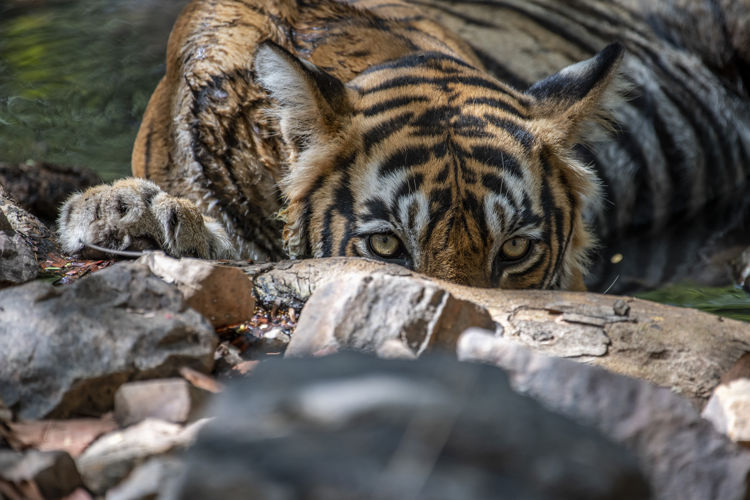During a hot summer day in June, our Maruti Gypsy jolted along a narrow jungle track. Suddenly, our forest guide signalled to his colleague travelling in another vehicle to rush towards a nearby meadow, where a tigress was resting at a watering hole.
Within seconds, tigress T-39, also known as Noor, came into view. At the Ranthambore National Park, Rajasthan, she has been given many names that endear her to foresters and visitors alike. She is called Mala (garland) because the wavy bead-like pattern on her bright skin is unique.
Noor was so close that even my zoom lens found it difficult to focus on her. Noor’s famous and most loved aunt, T-16, better known as Machli, roamed over the largest part of the 392-sq km national park. Like Machli, who died in August 2016 at the ripe age of 19, Noor is adaptive to human presence in her habitat. That one day, we “encountered” four Bengal tigers T-108 aka Jai, tigress Sultana and the most elusive and unfriendly T-101.

Two hundred years ago, tens of thousands of tigers roamed India and 29 other nations, from the Indonesian swamps to the Russian taiga. There were once Balinese, Caspian and Javanese subspecies, all now considered extinct. Today, just six subspecies remain.
The International Union for Conservation of Nature (IUCN) estimated in 2014 that there are only about 2,200 to 3,200 individual tigers in the wild – making them endangered. About 93% of the tiger’s historic range has emptied owing to habitat loss, poaching and depletion of prey. This spectre of a world without tigers led 13 nations to meet in 2010 in St Petersburg, Russia, where they declared that they would double their wild tiger numbers by 2022. But all except India, Nepal and Bhutan are struggling to save their tigers, even in protected reserves.
India remains the beacon of hope with roughly two-thirds of the world’s tigers. In 2019, it invested Rs 350 crore in tiger conservation, including relocating villages outside protected areas. It also built the world’s largest animal underpasses to funnel tigers safely beneath NH-44, offering a safe passage for animals. These cave-like, concrete underpasses, in the ecologically sensitive Kanha-Pench Corridor, are layered with natural soil so they retain the natural habitat of the animals. The underpasses are fitted with CCTV cameras to monitor their movement.
The government says, its efforts have paid off. It announced in July 2021 that the number of Royal Bengal Tigers doubled from 1,411 in 2006 to 2,967—meaning that India met the St Petersburg’s target. The census estimated 2,967 tigers, which means India has 75 per cent of the global tiger population.

Prime Minister Narendra Modi declared that tiger conservation could go hand in hand with building roads, railways and homes. "Once the people of India decide to do something, there is no force that can prevent them from getting the desired results," said Modi, "we reaffirm our commitment towards protecting tigers.”
India's tigers are a shining example of Aatmanirbhar Bharat, as Environment Minister Prakash Javadekar put it after the Guinness world records acknowledged that the fourth cycle of the All India Tiger Estimation 2018 is the world's largest camera trap wildlife survey. Camera traps were placed at 26,838 locations where they took 76,651 photographs of tigers. Stripe-pattern-recognition software helped identify individuals from that pile of photos.
India has done a lot since 1973 when Project Tiger was launched. In 2005, National Tiger Conservation Authority (NTCA) was established. In 1973, there were nine tiger reserves, now there are 50 in 18 states. But parse the country’s tiger data, the story becomes murky. The animals are increasingly becoming isolated in small reserves that prioritize tourism. If the cats leave the parks, their risks are enormous. NTCA and experts are trying to get a more accurate count of populations in specific areas and studying how to get people and the carnivores to coexist.
The country holds just 25% of total tiger habitat but accounts for nearly 75 per cent of global wild tigers. India’s protected areas have not expanded at the same rate as its tiger population, forcing some big cats to turn to human dominated landscapes for survival. Livestock gets killed and sometimes even people.
Rural Indians are unique in the world for their high tolerance to co-existing with potentially deadly wildlife. “You don’t find this in other cultures,” says Ullas Karanth, an expert on tigers. “If this kind of thing happened in Montana or Brazil, they’d wipe out everything the next day.”
Now, the tiger is watched, its ecology and behaviour are studied, and efforts are made to protect it and its space. Specific guidelines have been issued and specific projects are on. There is a huge challenge of balancing competing economic interests without compromising the integrity of our tiger landscapes and corridors. The future of tiger conservation depends on how we deal with these emerging issues.
(All photographs by Mrityunjoy Kumar Jha)




















